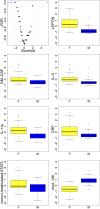Systems analysis of sex differences reveals an immunosuppressive role for testosterone in the response to influenza vaccination
- PMID: 24367114
- PMCID: PMC3896147
- DOI: 10.1073/pnas.1321060111
Systems analysis of sex differences reveals an immunosuppressive role for testosterone in the response to influenza vaccination
Abstract
Females have generally more robust immune responses than males for reasons that are not well-understood. Here we used a systems analysis to investigate these differences by analyzing the neutralizing antibody response to a trivalent inactivated seasonal influenza vaccine (TIV) and a large number of immune system components, including serum cytokines and chemokines, blood cell subset frequencies, genome-wide gene expression, and cellular responses to diverse in vitro stimuli, in 53 females and 34 males of different ages. We found elevated antibody responses to TIV and expression of inflammatory cytokines in the serum of females compared with males regardless of age. This inflammatory profile correlated with the levels of phosphorylated STAT3 proteins in monocytes but not with the serological response to the vaccine. In contrast, using a machine learning approach, we identified a cluster of genes involved in lipid biosynthesis and previously shown to be up-regulated by testosterone that correlated with poor virus-neutralizing activity in men. Moreover, men with elevated serum testosterone levels and associated gene signatures exhibited the lowest antibody responses to TIV. These results demonstrate a strong association between androgens and genes involved in lipid metabolism, suggesting that these could be important drivers of the differences in immune responses between males and females.
Keywords: aging; gender; immuno-endocrine; immunosenescence; sexual dimorphism.
Conflict of interest statement
The authors declare no conflict of interest.
Figures



Similar articles
-
Sexual diergism in antibody response to whole virus trivalent inactivated influenza vaccine in outbred mice.Vaccine. 2015 Oct 13;33(42):5546-5552. doi: 10.1016/j.vaccine.2015.09.006. Epub 2015 Sep 14. Vaccine. 2015. PMID: 26382601
-
Longitudinal analysis of the peripheral B cell repertoire reveals unique effects of immunization with a new influenza virus strain.Genome Med. 2015 Nov 25;7:124. doi: 10.1186/s13073-015-0239-y. Genome Med. 2015. PMID: 26608341 Free PMC article.
-
Comparison of neutralizing antibody and cell-mediated immune responses to pandemic H1N1 2009 influenza virus before and after H1N1 2009 influenza vaccination of elderly subjects and healthcare workers.Int J Infect Dis. 2012 Aug;16(8):e621-7. doi: 10.1016/j.ijid.2012.04.010. Epub 2012 Jun 15. Int J Infect Dis. 2012. PMID: 22704721
-
Differences in antibody responses between trivalent inactivated influenza vaccine and live attenuated influenza vaccine correlate with the kinetics and magnitude of interferon signaling in children.J Infect Dis. 2014 Jul 15;210(2):224-33. doi: 10.1093/infdis/jiu079. Epub 2014 Feb 4. J Infect Dis. 2014. PMID: 24495909 Free PMC article.
-
Artificial Intelligence Applied to in vitro Gene Expression Testing (IVIGET) to Predict Trivalent Inactivated Influenza Vaccine Immunogenicity in HIV Infected Children.Front Immunol. 2020 Oct 5;11:559590. doi: 10.3389/fimmu.2020.559590. eCollection 2020. Front Immunol. 2020. PMID: 33123133 Free PMC article.
Cited by
-
Evolving understanding of autoimmune mechanisms and new therapeutic strategies of autoimmune disorders.Signal Transduct Target Ther. 2024 Oct 4;9(1):263. doi: 10.1038/s41392-024-01952-8. Signal Transduct Target Ther. 2024. PMID: 39362875 Free PMC article. Review.
-
Sex differences in symptoms following the administration of BNT162b2 mRNA COVID-19 vaccine in children below 5 years of age in Germany (CoVacU5): a retrospective cohort study.Biol Sex Differ. 2024 Sep 26;15(1):74. doi: 10.1186/s13293-024-00651-x. Biol Sex Differ. 2024. PMID: 39327617 Free PMC article.
-
Mechanisms of long COVID and the path toward therapeutics.Cell. 2024 Oct 3;187(20):5500-5529. doi: 10.1016/j.cell.2024.07.054. Epub 2024 Sep 25. Cell. 2024. PMID: 39326415 Review.
-
High-fat and High-sucrose Diet-induced Hypothalamic Inflammation Shows Sex Specific Features in Mice.Neurochem Res. 2024 Dec;49(12):3356-3366. doi: 10.1007/s11064-024-04243-4. Epub 2024 Sep 20. Neurochem Res. 2024. PMID: 39302596 Free PMC article.
-
Estrogen-dependent gene regulation: Molecular basis of TIMP-1 as a sex-specific biomarker for acute lung injury.Physiol Rep. 2024 Sep;12(17):e70047. doi: 10.14814/phy2.70047. Physiol Rep. 2024. PMID: 39267201 Free PMC article.
References
Publication types
MeSH terms
Substances
Associated data
- Actions
Grants and funding
LinkOut - more resources
Full Text Sources
Other Literature Sources
Medical
Miscellaneous

